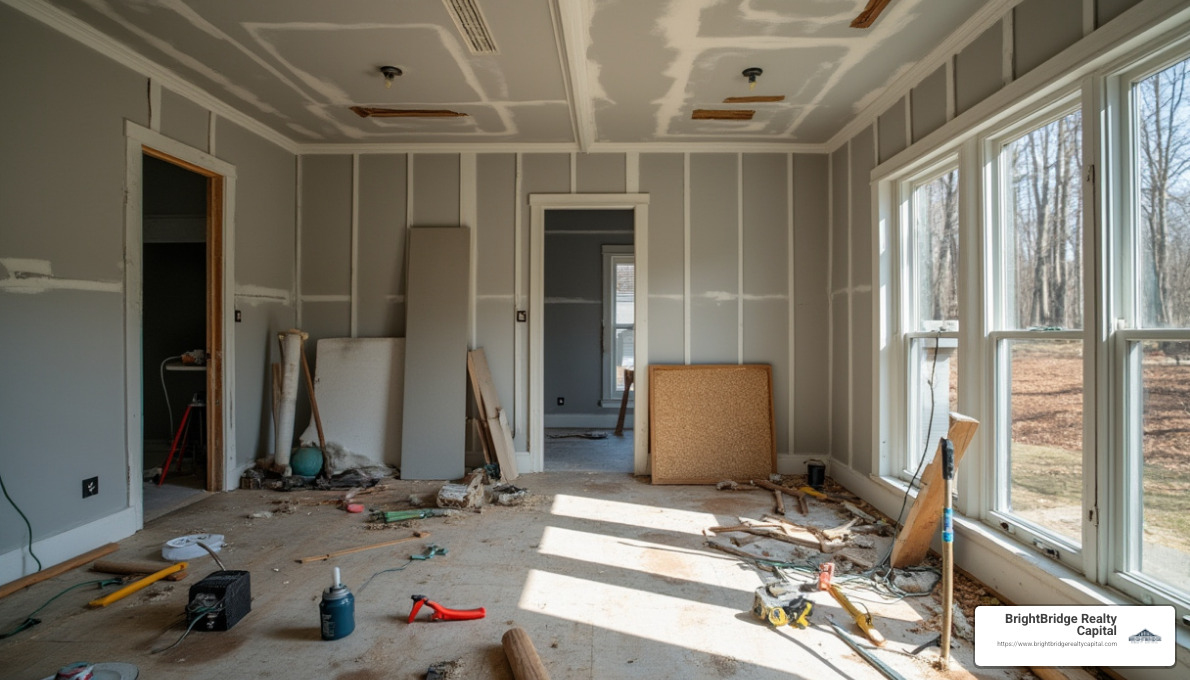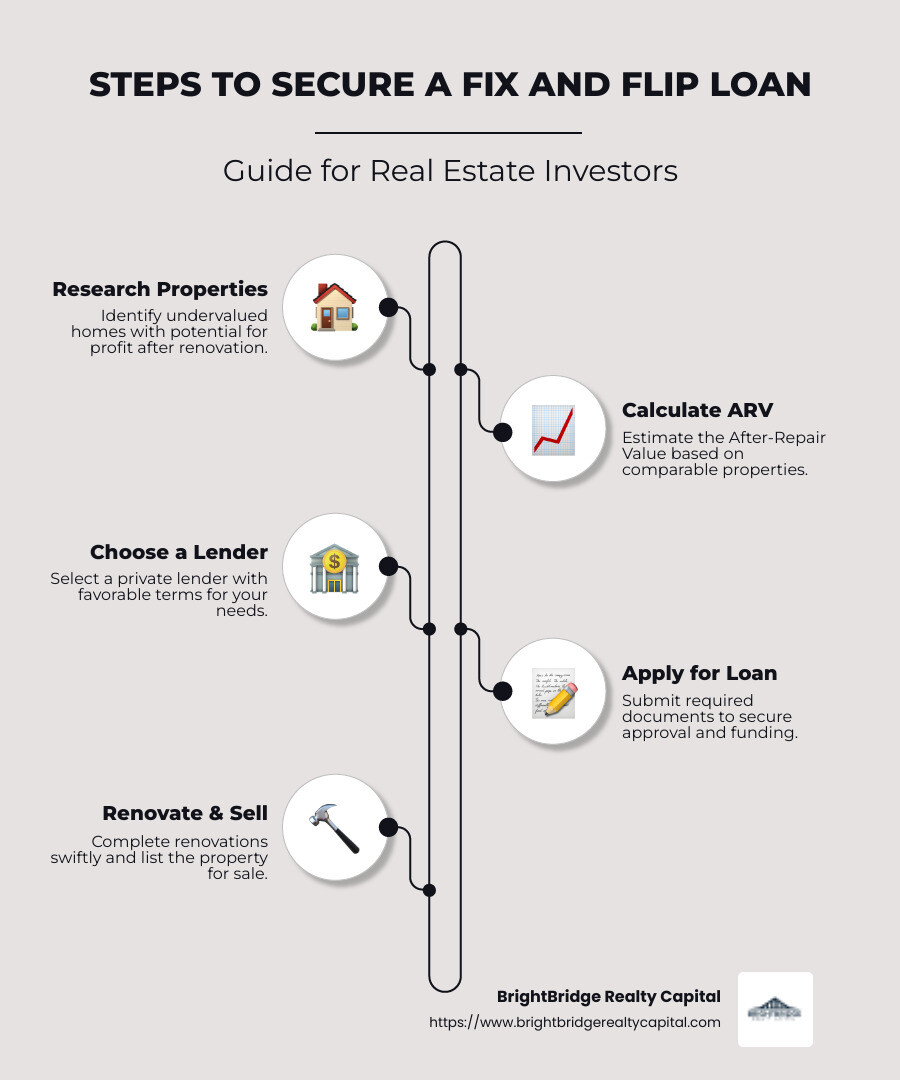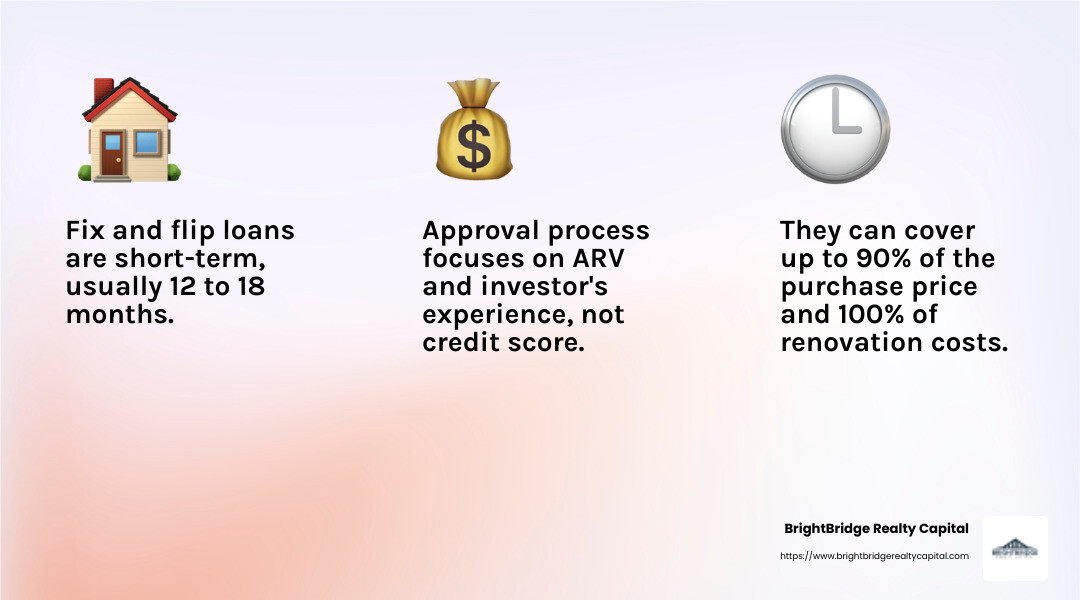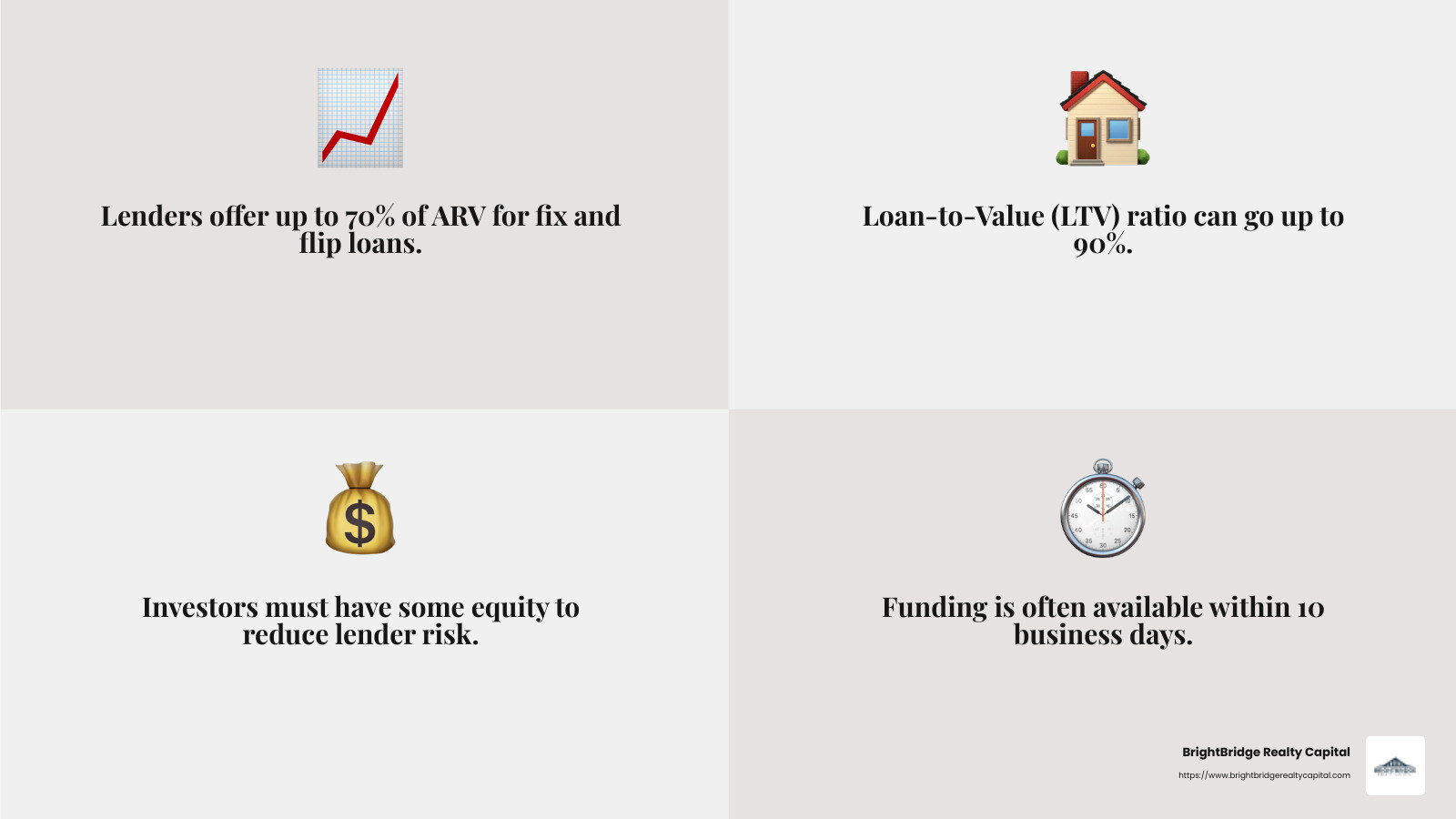Fix and Flip Loans Demystified: How They Work

How does a fix and flip loan work? At its core, a fix and flip loan is a short-term, hard money loan designed specifically for purchasing, renovating, and reselling a property quickly. These loans usually feature a fast approval process, flexible terms, and are typically offered by private lenders rather than traditional banks. They primarily focus on a property's potential value post-renovation, known as the After-Repair Value (ARV), rather than its current condition. This makes them ideal for investors looking to transform undervalued properties into lucrative deals.
House flipping has become a cornerstone of real estate investment, enticing many with the promise of rapid returns. It's an approach where investors buy undervalued homes, renovate them, and quickly sell them to capitalize on market demand.
In this field, timing is crucial, and having the right financial backing is even more critical. Fix and flip loans offer investors a streamlined pathway to finance these projects fast and efficiently. They allow investors to turn visions into profits without the lengthy procedures of traditional mortgage loans.
For aspiring and seasoned real estate investors, understanding fix and flip loans is essential to optimizing investment strategies. Here’s a glimpse into how these loans operate to improve your real estate success.

Simple guide to how does a fix and flip loan work:
- fix and flip real estate investing
- real estate loans for flipping houses
- short term loans for flipping houses
What is a Fix and Flip Loan?
In real estate investment, fix and flip loans are a game-changer. These loans are a type of short-term financing specifically crafted for the environment of house flipping. Unlike traditional mortgages, which can take months to process, fix and flip loans are designed to be quick and flexible.
Short-term Financing
Fix and flip loans are known for their short durations, usually ranging from 12 to 18 months. This short-term nature is perfect for investors aiming to buy, renovate, and sell a property in a tight timeframe. The quick turnaround is essential because it allows investors to capitalize on market opportunities without getting bogged down by lengthy loan terms.
Real Estate Loans
These loans are a specialized form of real estate financing. They focus on the potential value of the property after renovations, rather than its current market value. This is known as the After-Repair Value (ARV). Lenders look at the ARV to determine how much they are willing to loan, often covering up to 90% of the purchase price and 100% of the renovation costs.
Hard Money Loans
The term "hard money loan" is often synonymous with fix and flip loans. These loans are typically provided by private investors or companies rather than traditional banks. The approval process is fast and less stringent, focusing more on the property's value and the investor's experience rather than the borrower's credit score. This makes them accessible even to those who might not qualify for conventional loans.

Hard money loans usually come with higher interest rates compared to traditional loans. This is because they are riskier for lenders, given the short-term nature and the potential volatility of real estate markets. However, for investors, the speed and flexibility often outweigh the higher costs.
In summary, fix and flip loans are an essential tool for real estate investors looking to make quick profits by buying, renovating, and selling properties. They offer the flexibility and speed needed to thrive in the competitive world of property flipping, allowing investors to focus on maximizing their returns.
How Does a Fix and Flip Loan Work?
Understanding how a fix and flip loan works is crucial for any real estate investor looking to dive into house flipping. These loans are all about quick action and maximizing returns.
Loan Approval Process
The approval process for a fix and flip loan is different from traditional loans. Instead of focusing on the borrower's credit score, lenders prioritize the potential value of the property after renovation, known as the After-Repair Value (ARV). This is a key metric because it estimates what the property will be worth once all the improvements are complete. Lenders often use the ARV to decide how much to lend, typically offering up to 70% of this future value.
Another important term is the Loan-to-Value (LTV) ratio. This compares the loan amount to the property's current value. For fix and flip loans, the LTV can go up to 90%, meaning lenders might finance 90% of the property's purchase price. This is particularly advantageous for investors who don't want to tie up too much of their own money.
Investor's equity also plays a role. Lenders like to see that investors have some skin in the game, which shows commitment and reduces risk. This equity can come from a down payment or previous successful projects.

Funding and Repayment
Once approved, funding is fast—often within 10 business days. This quick funding allows investors to seize opportunities in competitive markets without delay. Traditional bank loans can take 45 to 60 days, which could mean missing out on a prime deal.
Interest-only payments are typical for fix and flip loans. This means during the loan term, investors only pay the interest, not the principal. This keeps monthly payments lower, freeing up cash for renovations. Once the property is sold, the principal is repaid in full.
The terms of these loans are flexible, usually ranging from 12 to 18 months. This short-term nature aligns with the world of house flipping, giving investors the time they need to complete renovations and sell the property without long-term financial commitments.
Fix and flip loans are designed to provide the speed, flexibility, and financial support that real estate investors need to successfully buy, renovate, and sell properties for a profit.
Types of Fix and Flip Financing
When diving into house flipping, understanding the different types of financing options is crucial. Each type has its own benefits and drawbacks, and choosing the right one can make a big difference in your project's success.
Hard Money Loans
Hard money loans are a popular choice for fix and flip investors. These loans come from private investors rather than traditional banks. This means the approval process is typically faster—often within one to two weeks. This speed is vital in competitive real estate markets where opportunities can vanish quickly.
However, the fast approval comes at a cost. High-interest rates are common with hard money loans, making them more expensive than traditional financing. But for those with less-than-perfect credit or those needing quick cash, these loans are a viable option. They focus more on the property's potential value rather than the borrower's credit score.
Home Equity Lines of Credit (HELOC)
Another financing option is the Home Equity Line of Credit (HELOC). This allows homeowners to borrow against the equity in their personal residence. Think of it as a credit card with a set limit based on your home's value. You can draw funds as needed for renovations, making it flexible for ongoing projects.
The benefits of a HELOC include competitive interest rates and the ability to access funds only when needed. However, this comes with a risk—your home is on the line. If you can't make payments, you could face foreclosure. Therefore, ensure that your flip is profitable to cover these payments.
Business Lines of Credit
For established flippers, a business line of credit is another option. This type of financing allows investors to borrow against their business assets. Like a HELOC, you can draw funds as needed, making it perfect for unpredictable renovation costs.
To qualify, you'll need a solid business credit score and financial history. The flexibility of a business line of credit is its main advantage, as you only pay interest on the amount you use. This makes it a smart choice for experienced investors who want to manage cash flow efficiently during a flip.
Each financing option has its unique features and risks. It's essential to assess your situation and choose the one that aligns best with your investment strategy and financial goals.
Key Differences Between Fix and Flip Loans and Traditional Mortgages
When considering the best financing option for house flipping, it's crucial to understand how fix and flip loans differ from traditional mortgages. Let's break it down into three main areas: loan term, property condition, and credit score considerations.
Loan Term
Fix and flip loans are designed for short-term projects. Unlike traditional mortgages that often span 15 to 30 years, these loans typically last from 6 to 24 months. This short duration aligns with the quick turnaround needed in house flipping.
One significant advantage is the interest-only payment structure. This means you only pay the interest during the loan term, keeping monthly payments lower. Plus, there are usually no early payment penalties. This flexibility allows you to repay the loan as soon as you sell or refinance the property, making it ideal for real estate markets.
Property Condition
Traditional mortgages usually require the property to be in good condition before approval. This can be a hurdle for investors looking to purchase distressed properties. Fix and flip loans, however, focus on the after-repair value (ARV). This is the estimated value of the property after renovations are complete.
This focus on ARV means you can secure financing even if the property needs significant repairs. The loan covers both the purchase price and the renovation costs, making it easier to invest in properties that traditional lenders might shy away from. This is a huge benefit for those aiming to transform distressed properties into profitable investments.
Credit Score Considerations
Traditional lenders place a heavy emphasis on the borrower's credit score. A low score can make it challenging to secure a mortgage with favorable terms. In contrast, fix and flip loans are more flexible. They prioritize the property's value and the investor's equity over personal credit history.
This flexibility opens doors for investors with a strong real estate portfolio or substantial equity in a property, even if their credit score isn't stellar. It allows a broader range of investors to enter the house flipping market, providing opportunities to those who might not qualify for traditional financing.
Understanding these key differences can help you choose the right financing option for your real estate investment strategy. Whether you're a seasoned investor or just starting, knowing how fix and flip loans work can give you a competitive edge in the market.
Frequently Asked Questions about Fix and Flip Loans
How Does a Fix and Flip Loan Work?
Understanding fix and flip loans is crucial for anyone diving into real estate investing. One common question is about the interest rates. Typically, these loans have higher interest rates compared to traditional mortgages. This is due to the short-term nature and higher risk involved. Rates can vary, but they often range from 8% to 12%.
What are the typical interest rates?
The interest rates for fix and flip loans are generally higher than regular mortgages. You might see rates between 8% and 12%. These rates reflect the short-term risk lenders take on. It's important to factor in these costs when planning your investment.
How quickly can I get funding?
Speed is a major advantage of fix and flip loans. In the world of real estate, quick funding can make all the difference. Most lenders can approve and fund these loans in as little as 10 business days. This quick approval process allows investors to act fast on promising properties, giving them a competitive edge in the market.
Can I get a fix and flip loan with bad credit?
Yes, you can. Unlike traditional mortgages, fix and flip loans are more lenient with credit scores. Lenders focus more on the property's value and the investor's equity. This means that even if your credit score isn't perfect, you could still qualify. This flexible criteria makes these loans accessible to a wider range of investors, opening up opportunities for those with less-than-ideal credit histories.
Understanding these aspects of fix and flip loans can help you make informed decisions and maximize your investment potential. Whether you're concerned about interest rates, need quick funding, or have a less-than-perfect credit score, these loans offer flexible solutions custom to the world of real estate investing.
Conclusion
At BrightBridge Realty Capital, we understand the unique needs of real estate investors. Our customized financing solutions are designed to meet those needs with precision and speed. Whether you're a seasoned investor or just starting out, our fix and flip loans provide the fast, flexible funding you need to succeed.
Our seamless process is one of our standout features. We know that in real estate, time is money. That's why we offer quick closings, often within a week, allowing you to act swiftly on investment opportunities. Our direct lending approach eliminates intermediaries, ensuring competitive rates and a smooth transaction from start to finish.
We specialize in providing customized financing solutions that cater to the specific demands of the fix and flip market. With our expertise, you can confidently steer the complexities of real estate investing and focus on what you do best—turning properties into profit.
For more information on how we can assist with your real estate investment needs, explore our offerings at BrightBridge Realty Capital. Let us be your trusted partner in achieving your investment goals.


